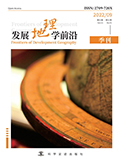

在高质量发展背景下, 科技创新、人才集聚与新型城镇化三大系统相融合的发展范式已经成为区域发展的关键问题。本文以长江经济带为例, 在区域高质量发展视角下解析三大系统相互作用机理并构建评价指标体系, 通过综合熵权TOPSIS、耦合协调度模型和Dagum基尼系数探究三大系统耦合协调时空特征及区域差异, 并用马尔科夫链模型对三大系统耦合协调类型演进趋势进行预测。研究表明: ①长江经济带三大系统发展指数均呈上升态势, 三大系统耦合协调度整体处于磨合阶段, 长江上游制约耦合协调度的阻力主要为科技创新滞后, 长江中、下游为人才集聚滞后; ②长江经济带三大系统耦合协调度具有明显的空间集聚特征, 均呈现出长江下游高水平, 长江中、上游低水平的空间格局; ③长江经济带三大系统耦合协调度差距呈逐步缩小态势, 各区域间的发展差距较大仍然是长江经济带基尼系数的构成主因; ④长江经济带三大系统耦合协调等级转移概率存在区位差异, 长江上游和中游在下一阶段将仍将处于拮抗或磨合阶段, 而长江下游将处于协调阶段。研究结论为长江经济带高质量发展提供参考。
In the context of high-quality development, the development paradigm of integrating scientific and technological innovation, talent agglomeration, and new-type urbanization has become a key issue in regional development. Taking the Yangtze River Economic Belt as an example, this paper analyzes the interaction mechanism of the three systems and constructs an evaluation index system from the perspective of regional high-quality development. This paper combined entropy weight TOPSIS, coupling coordination degree model, and Gini coefficient to explore the spatial and temporal characteristics and regional differences of system coupling coordination. The evolution trend of the coupling coordination type is predicted by the Markov chain model. The research shows that: (1) The development index of the three major systems in the Yangtze River Economic Belt is on the rise, and the coupling coordination degree is in the running-in stage as a whole. The resistance restricting the coupling coordination degree is mainly the lag of scientific and technological innovation in the upstream, and the lag of talent gathering in the middle and downstream. ( 2) The coupling coordination degree of the three systems has obvious spatial agglomeration characteristics, showing a high level in the lower reaches of the Yangtze River, and a low level in the middle and upper reaches of the Yangtze River. (3) The gap of the coupling coordination degree of the three systems in the whole Yangtze River Economic Belt is gradually narrowing, and the large development gap among different regions is still the main cause of the Gini coefficient of the Yangtze River Economic Belt. (4) There is a location difference in the probability of coupling coordination level transfer, and the upper and middle reaches of the Yangtze River will still be in the antagonistic or running-in stage in the next stage, while the lower reaches of the Yangtze River will be in the coordination stage. The research conclusions provide scientific references for the high-quality development of the Yangtze River Economic Belt.